*The following is for patients with long-term breathing difficulties/ shortness of breath. If you have just started to have difficulty breathing or find your condition deteriorating, please consult your doctor.
About Difficulty Breathing/Shortness of Breath
Causes of long-term difficulty breathing include:
- Cardiopulmonary disease-related: Heart failure, chronic obstructive pulmonary disease, chest infections, blood clots in lung vessels
- Cancer-related: Cancers involving the lungs, malignant pleural effusion, pressure on the diaphragm due to liver cancer or ascites, side effects of cancer treatments
- Others: Anaemia, fatigue/ weakness, pain, anxiety and panic
Medical Treatment
- Doctors will formulate treatment plans based on the degree of difficulty breathing
- Taking the chronic obstructive pulmonary disease as an example, the commonly used medications include bronchodilators, mucolytics, antibiotics and steroids
- When necessary, doctors may prescribe opioids to relieve the breathing difficulty. Consult healthcare professionals in case of any questions
Non-medical Treatment
Here are some strategies to help patients in managing breathing problems:
Use a handheld electric fan
Cooling your face with a fan helps relieve difficulty breathing.
- Method: Fix the fan at about six inches away from the face and let the cool breeze blow to the middle of the face. The patient should feel the symptoms relieving in a few minutes
- For first-time users, check if the patient shows any signs of discomfort, such as dizziness and cold. In case of discomfort, adjust the distance or wind speed of the fan
Consult your therapist in case of any questions.
Posture to relieve difficulty breathing
Relax the muscles and lower the diaphragm to alleviate difficulty breathing.
Sitting posture
- Lean forward, rest your forearms on your thighs or on a table with pillows, rest your feet on the floor with legs apart
- This sitting posture allows the muscles to be in a better position to help breathing
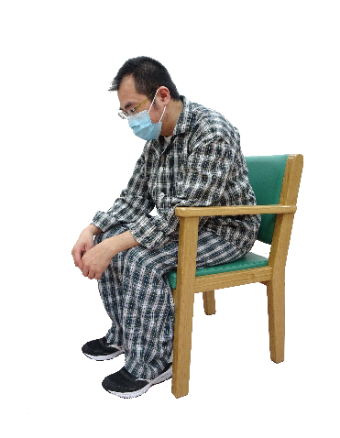
Standing
- If you cannot find anywhere to sit down, lean against some fixed or stable objects, such as wall, fence or a stable table
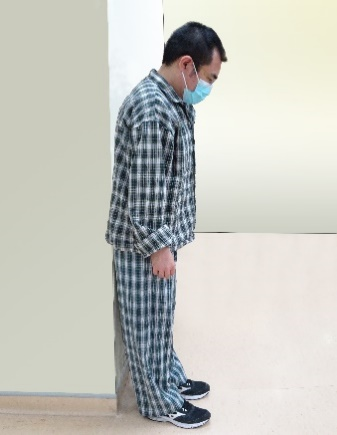
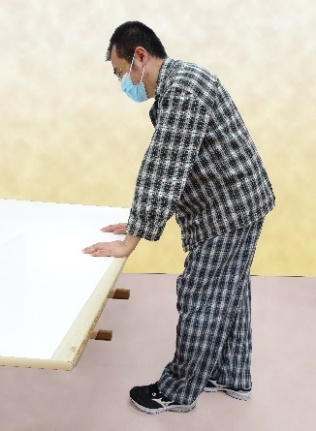
Consult your therapist in case of any questions.
Breathing techniques
Mastering breathing techniques can help patients deal with the symptoms of difficulty breathing. The following breathing techniques can be combined with handheld electric fan or the postures for relieving breathing difficulties.
(a) Pursed lip breathing
- When you breathe, first inhale through your nose in two seconds
- Then purse out your lips to exhale as if you were blowing a candle lightly. The blowing time is around four to six seconds. Do not exhale forcefully
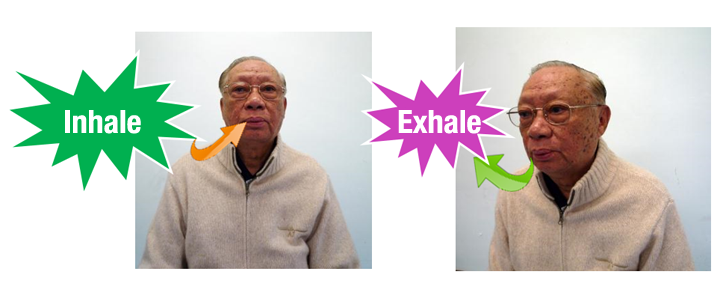
The internal airway pressure created by exhaling through the pursed lips keeps the trachea open, making it easier to exhale air out of the lungs and leaving more lung space for the next inhalation.
Consult your therapist in case of any questions.
(b) Abdominal breathing (diaphragmatic breathing) method
Compared with breathing driven by upper chest, neck and shoulder muscles, this is a more effective breathing technique and less physically demanding:
- Gently place your hands on your upper belly to relax your abdominal muscles
- When inhaling slowly through the nose, try to inhale into the bottom of the lungs; let your hands rise gently with the bulge of the abdomen
- When exhaling slowly with pursed lips, feel the abdomen drop
- Rest and wait for the next breath
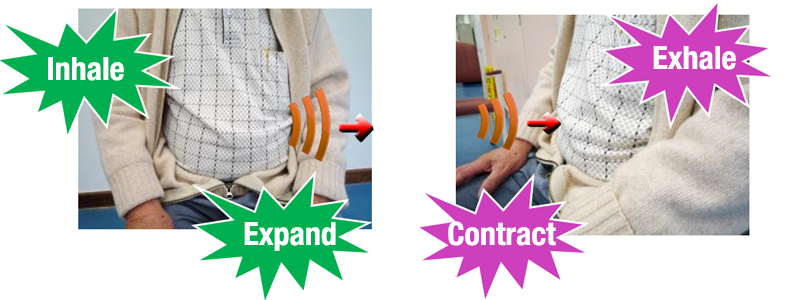
At first, you may not be able to do the abdominal breathing naturally. You are recommended to practise more when you do not have difficulty breathing.
Consult your therapist in case of any questions.
(c) Coordinated breathing with movement
- Apply some force
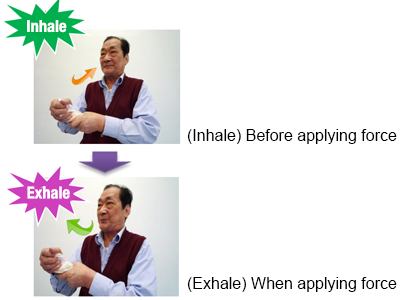
- Raise your arms
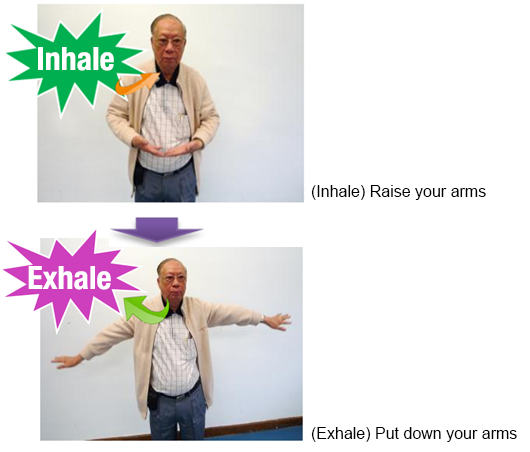
- Bend down
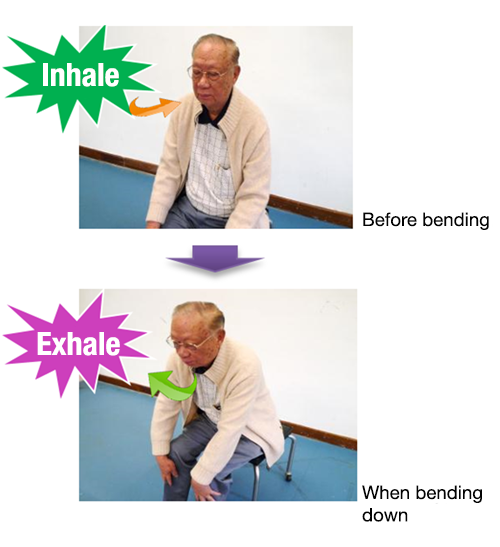
Consult your therapist in case of any questions.
(e) Relaxation exercise with breathing
Slowly stretch out your arms and do the breathing exercise
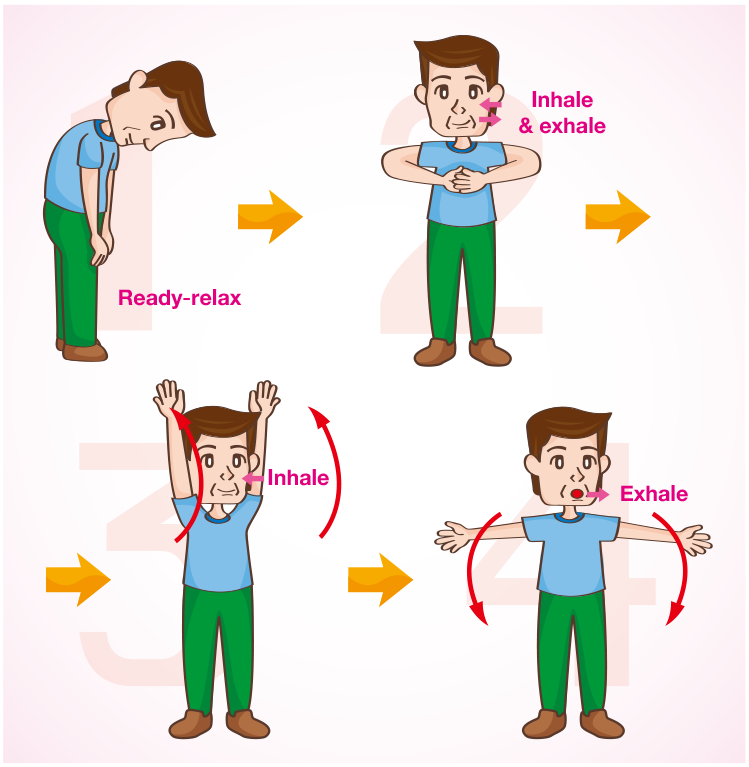
Consult your therapist in case of any questions.
Breathing difficulty caused by lying down
Choose beds with adjustable height or backrests to relieve the symptoms.
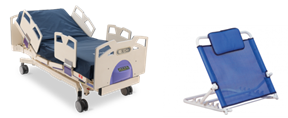
Relaxation training and anxiety management
- Relaxation can help slow down breathing and improve breathing efficiency
- If family members can keep the patients company, gently stroke their back to make them feel safe and relieve anxiety
- Relaxation is a kind of personal experience; you need to find the way that suits you
Reference: Simple breathing exercise
- Stay relaxed, sit down, rest your back on a chair and your feet on the floor; you may also lay down and put your hands on your lower belly
- Close your eyes and feel if you are still in a tense state
- Slowly inhale through the nose and count to one
- Slowly exhale through your mouth and count two and three. Imagine being in a peaceful and delightful place, such as a beach or field
- Keep calm and relax your body and limbs. Repeat the inhalation and exhalation for three to five times, or until you feel relaxed
- When you are about to finish the relaxation exercise, count to three
- Gently move your lower body
- Gently move your upper body
- Slowly inhale, open your eyes, exhale and tell yourself: “I feel comfortable physically and mentally.”
Point to Note on Daily Living
Plan your daily activities beforehand
Excessive or overly intense activities may worsen breathing difficulties. Therefore, patients should rearrange their daily routine according to their ability.
- It is recommended that the patients plan their daily activities beforehand and set priorities. It may be necessary to organise the number of activities and arrange them at different times to save energy. Allow enough time to complete the tasks and arrange resting period when necessary
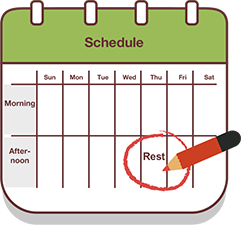
- For more exertional activities such as taking a shower, control the breathing activities before you start. You can also put a chair with a suitable height in the bathroom so that you can sit down during the shower. You may also arrange these activities after taking medication for control of breathlessness
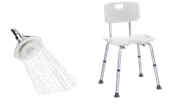
- For patients with mobility difficulties, consider using urinal, bed pan, bedside commode or mobile commode to assist toileting and showering. Carers should assess their own abilities, sponge bath or bed bath instead of bathing in bathroom when necessary, and seek help
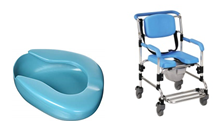
Recommendation for going outdoor and shopping
- Try to match your breathing and walking pace. For example, take one step when you inhale and two steps when you exhale; keep your breathing rhythm steady and avoid holding your breath; walk at a comfortable pace and avoid walking too fast at a stretch
- Use walking aids when appropriate and consider bringing a trolley when you go shopping
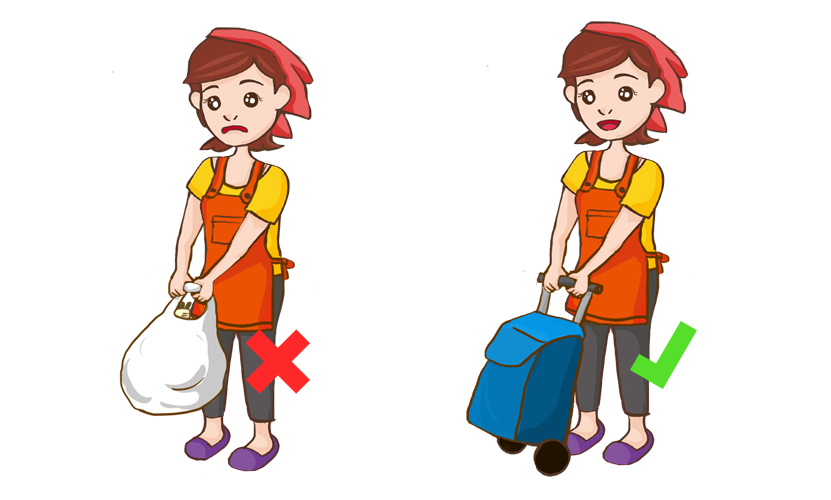
Stay active
An appropriate amount of exercise can improve breathing and prevent muscle atrophy. Even if the patients have serious lung problems, they can still do a small amount of exercise. Consult your therapist in case of any questions.
Keep the indoor environment cool and fresh
- Use air conditioners, fans, dehumidifiers or air filters to keep the air fresh, dry and circulated
- Do breathing relaxation exercises every day
- Follow the doctor’s instructions for taking medication; understand the usage and function of the medicine
- If the breathing difficulties are caused by sticky sputum and saliva blocking the airway, drink hot water to dilute the sputum and saliva to help with coughing it up
- Keep bowl movements smooth and avoid forcing defecation which may increase breathing difficulties
When the patients have a low blood oxygen level, they may require oxygen therapy. However, not everyone with breathing difficulty is suitable for oxygen therapy. Do not use oxygen therapy without doctor’s advice. Incorrect use of oxygen can harm your body.
Oxygen concentrator
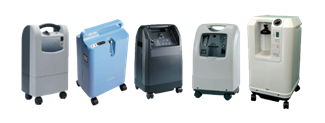
Portable oxygen cylinder
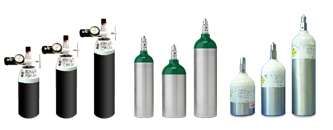
- Home oxygen therapy can only be used with doctor’s prescription
- Patients can rent oxygen equipment to use at home (you can seek assistance from healthcare professionals.)
- Things to note while using home oxygen therapy:
- Keep the airway clear, for example: encourage the patients to cough up the sputum and clear the secretions in the mouth and nose, so that oxygen can effectively enter the lungs
- To ensure that oxygen can enter the airway, make sure the nasal cannula is placed in the nostril, or the mask is placed over the nose and mouth
- Clean the nasal cannula or oxygen mask every day
- The oxygen supply must be kept clear from the kitchen stove, any fire or cigarette butts to prevent explosions